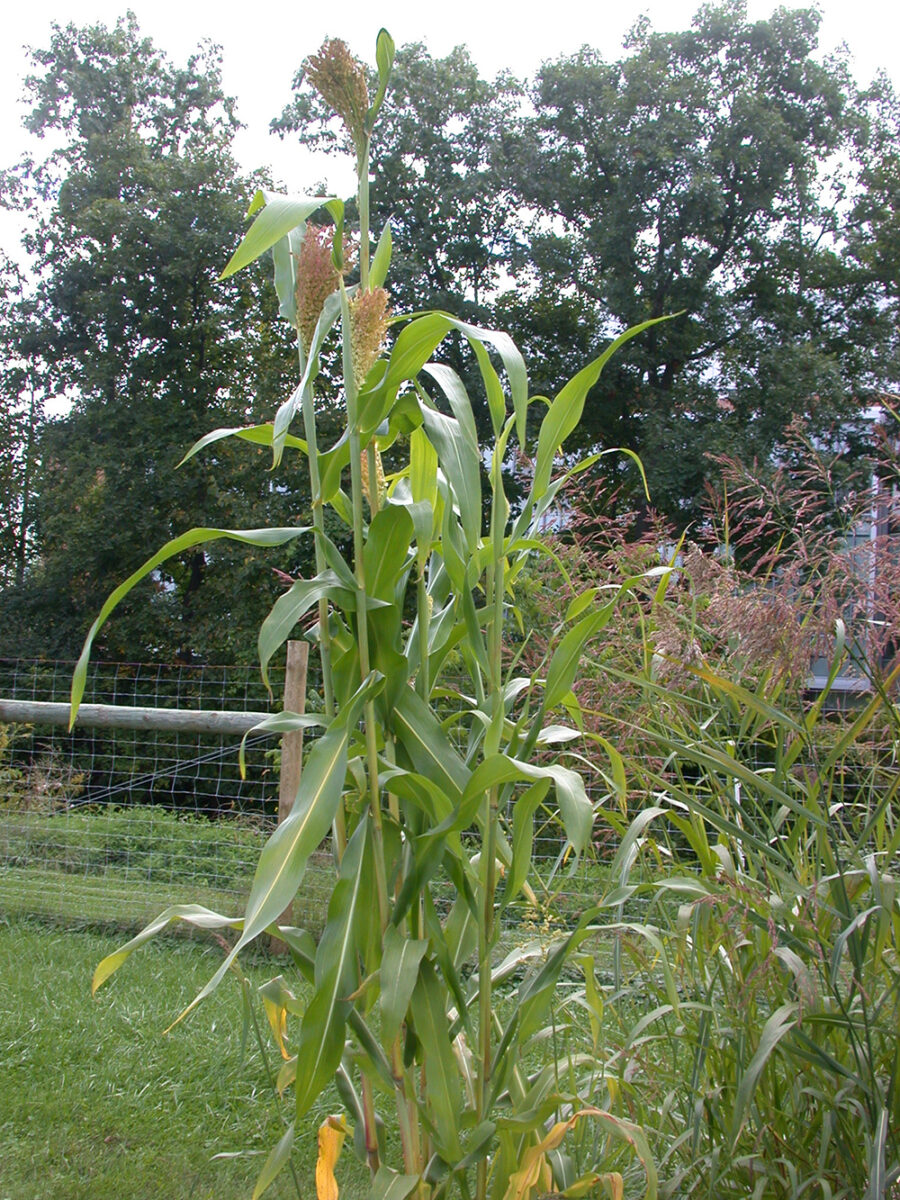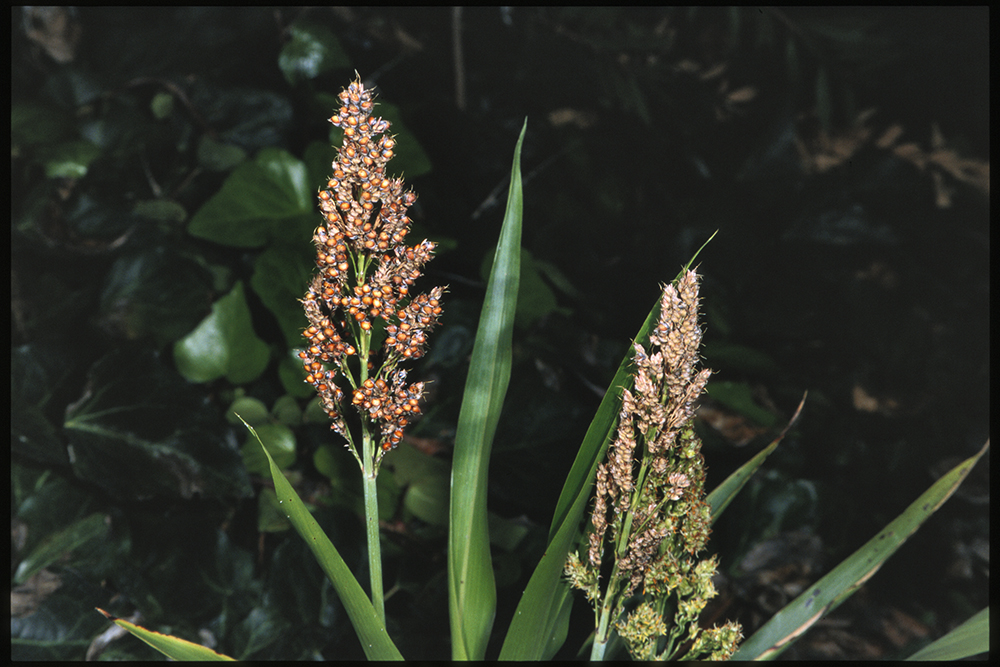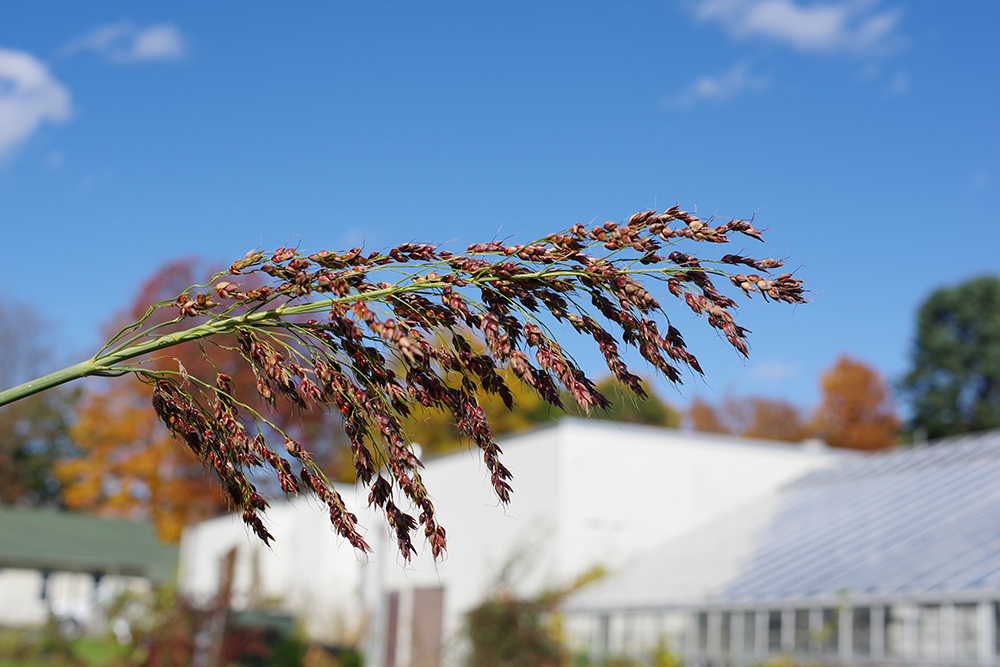Other common names: sorghum, black amber cane, wildcane, milo, chicken corn



Sorghum bicolor (L.) Moench ssp. verticilliflorum (Steud.) de Wet ex Wiersema & J. Dahlb.
Identification of Shattercane
Family: Grass family, Poaceae
Habit: Tall, upright annual grass
Taxonomic note: The taxonomic status of shattercane is controversial. Some recent authors have used Sorghum bicolor (L.) Moench nothosubsp. drummondii (Steud.) de Wet ex. Davidse for shattercane, but USDA Plants uses Sorghum bicolor (L.) Moench ssp. drummondii (Nees ex Steud.) de Wet & Harlan to refer to sudangrass. All competent authorities agree that shattercane is differentiated from domestic sorghum only at the subspecies level.
Description: Seedlings are similar in appearance to corn. Leaves are rolled in the bud, and the ligule is a translucent fringed membrane. The collar is whitish, and auricles are absent. Early leaves are 0.08–0.2 inch wide by 1.6–7 inches long and usually hairy at the base and otherwise hairless. Sheaths may or may not have hairs. Mature plants tiller to form clumps and can reach 8 feet in height. The stems are erect, unbranched, hairless and may have purple spots. Sheaths are smooth and open, with occasional scattered hairs near the collar. Auricles are absent. The ligule is a fringed, translucent membrane up to 0.2 inch long. Blades are 1–2 feet long by 1–4 inches wide, hairless to sparsely hairy, and have a prominent, pale green to white midvein. The roots are fibrous and branching, and brace roots develop at the base of the stem. The inflorescence is a compact to open, 3–20 inch-long panicle with whorled and upright branches that turn from green to reddish brown as it matures. Spikelets are paired, and each spikelet has one fertile and one infertile flower. The fertile flower is stalkless and 0.16–0.24 inch long with a 0.25–0.5 inch-long awn, whereas the infertile flower is stalked and lacks an awn. As with all grasses, seeds are covered with a thin, tight, hard layer of fruit tissue. Seeds are red to black, 0.1–0.17 inch wide, oval and flattened. The seeds fall readily when ripe, and panicle branches may become fragile and break when mature.
Similar species: In domestic sorghum [Sorghum bicolor (L.) Moench ssp. bicolor], the short stem (rachilla) that attaches the seed to the main stem of the inflorescence breaks to free the seed during combining. In most biotypes of shattercane, a special layer of cells forms at the tip of the rachilla, which causes the seed to fall off spontaneously when ripe. In a few biotypes the rachilla itself becomes fragile at maturity and breaks spontaneously. Johnsongrass [Sorghum halepense (L.) Pers.] is similar to shattercane but is a perennial with large, scaly rhizomes and narrower (0.5–2 inches wide) leaves than shattercane. Seedlings of shattercane and johnsongrass are nearly indistinguishable, but if removed from the soil the attached seed coat may be used to differentiate them. Johnsongrass seeds are much smaller than shattercane seeds, just 0.06–0.08 inch wide. Corn (Zea mays L.) seedlings may be distinguished from shattercane by the larger attached seed of corn.
Management of Shattercane
Prevent movement of shattercane into uninfested fields by cleaning combines and tillage equipment. If shattercane is not already present in a field, avoid growing sorghum of any sort on that field. Essentially all sorghum seed contains at least a few seeds of shattering off-types that will introduce the weed to that field. If you have a compelling reason to grow sorghum on an uninfested field, plan to hand rogue out off-type individuals after the inflorescence has emerged but before they set seed. If plants have flowered, remove the cut plants from the field.
Where the weed is already present, management of the shattercane seed bank is critical. A season-long tilled fallow can reduce shattercane seed by 91%, but this may not be sufficient to make this approach worthwhile. In regions with mild winters, leave seeds on the soil surface until spring to maximize seed predation. In regions where the soil freezes, shallowly incorporate the seed to ensure they imbibe and thereby become subject to damage by freezing. Avoid deep burial in the fall as that will decrease the number of freeze-thaw cycles the seeds experience and may prevent freezing altogether. In the spring, bury the seeds deeply by moldboard plowing to reduce emergence. Although a few will return to the surface with next year’s tillage, the mortality rate of shattercane seeds is sufficiently high that most will not. Although shattercane continues to emerge through the summer, most seedlings appear in late spring and early summer, so delaying tillage and planting can reduce shattercane density in the crop.
Since many shattercane seedlings will emerge from below the working depth of a rotary hoe or tine weeder, the objective of in-row weeding must be to break or bury the seedlings rather than to uproot them. A tine weeder is better for these purposes. Plant soybeans at high density to allow for more aggressive weeding and consequently greater soybean stand loss. If conditions are favorable for continued shattercane emergence, a late tine weeding at the first to second trifoliate stage of the soybeans can be useful for removing new seedlings close to the row. Since shattercane can emerge late into the summer, delay the lay-by cultivation as long as is practical. If shattercane is a severe problem on the farm, consider obtaining a weed puller, electric discharge weeder or a mower to top the shattercane after it emerges above the crop. Since shattercane generally overtops grain sorghum, at least the first two options can be effective for managing the weed in sorghum. A mower that tops the weed will be most effective after the inflorescence has emerged but before the flowers have opened.
A dense, vigorous crop of winter grain or early planted spring grain will be well established by the time shattercane emerges and will suppress the weed. Since small grains are harvested before shattercane goes to seed, clean-up fields with tillage or mowing after harvest to prevent seed production and, in conjunction with good seed bank management, reduce the severity of an infestation. Harvesting corn or sorghum for forage before shattercane sets seed can also interrupt the life cycle of the weed. Although some shattercane seeds will likely survive through rotation of a field into alfalfa, many will not, and in any case, repeated mowing will prevent further seed production by the weed during the alfalfa portion of the rotation.
Ecology of Shattercane
Origin and distribution: The first shattercane varieties originated in northern sub-Saharan Africa along with domesticated sorghum. It probably emerged multiple times and has further evolved through multiple hybridizations between it, domesticated sorghum and wild Sorghum species around the world. It has been introduced into semi-arid areas of Asia, Europe, Australia and North America. It occurs throughout the United States and in southern Ontario and Quebec but is most problematic in the Midwest.
Seed weight: Mean population seed weights of shattercane range from 19–22 mg.
Dormancy and germination: A moderate proportion of the seeds is capable of germination immediately after falling from the parent plant. Late emerging plants produce a higher proportion of dormant seeds, and the proportion of dormant seeds probably also varies among populations. Removal of outer chaffs or slight damage to the seed coat (scarification) decreases dormancy. The optimal temperature for germination is 77–95°F, and germination is poor below 59°F. Temperature fluctuations promote germination and consequently, shade inhibits emergence by reducing temperature fluctuations. After burial, light promotes germination of seeds in some populations but not in others. Nitrogen fertilization does not promote germination.
Seed longevity: Shattercane is genetically diverse, and seed survival in soil varies with the biotype present. Long-term survival in soil depends on the tight outer chaffs that enclose the seed of most populations. Seeds buried at 8.7 inches under sod remained viable for as long as 13 years. Over 30% remained viable for eight years, but viability declined rapidly after that. In a subsequent experiment, viability of seeds buried 8 inches declined to 37–43% after the first year, and 0–3% were viable after five years. In another experiment, 1% of seeds from plants with open inflorescences survived for three years at 3–6 inches, but survival increased with burial at greater depths. Seeds from compact inflorescences did not survive more than one year unless deeply buried. In experiments in Nebraska, only 11–17% of seeds buried 1–5 inches in November survived until March, and most of the remaining seeds died within the next year. Covering seeded areas with clear plastic increased winter soil temperatures and seed survival, so overwinter seed survival is probably better in milder climates. Freezing greatly decreases viability. Progeny of outcrossed populations derived from grain sorghum and weedy shattercane had smaller, less tightly adhering outer chaffs than shattercane and were unable to survive one Nebraska winter on the soil surface.
Season of emergence: Shattercane begins to emerge in late spring and can continue to emerge throughout the summer.
Emergence depth: Shattercane emerges best from the top 1–2 inches, but 10–50% of seeds placed at 4 inches can successfully produce seedlings. Emergence has been observed from depths of more than 6 inches.
Photosynthetic pathway: C4
Sensitivity to frost: Shattercane is killed by frost and is injured by temperatures below 55°F.
Drought tolerance: Shattercane is moderately drought tolerant. If seed set is reduced by drought during flowering, side inflorescences can form to partially compensate for the loss.
Mycorrhiza: The species is mycorrhizal.
Response to fertility: Recommended rates of balanced N-P-K increased productivity of forage sorghum by 45% relative to no fertilizer. In competition with corn, shattercane took up significant amounts of nitrogen and subsequently reduced corn yields.
Soil physical requirements: Shattercane grows best on irrigated bottomlands. It does well on soil textures ranging from very fine sandy loam to silty clay loam and heavy clay.
Response to shade: The species is intolerant of shade, but due to rapid early growth supported by large seed reserves and its potentially tall height, it can often avoid shade by overtopping competing crops.
Sensitivity to disturbance: In Nebraska, plants cut before August will regrow and produce viable seeds before frost.
Time from emergence to reproduction: Shattercane in Wisconsin flowered 11 weeks after emergence. In Nebraska, shattercane produced seeds in eight to nine weeks. Seeds became viable 10 days after anthers emerged, and shattering occurred 9–12 days later. Shattercane plants that emerged as late as July in Nebraska were still able to produce viable seeds before a killing frost.
Pollination: Plants are primarily self pollinated, but cross pollination can also occur. The pollen can blow for a mile or more, which makes production of genetically pure sorghum seed difficult.
Reproduction: A shattercane inflorescence produces 500–1,500 seeds, so a typical plant with three heads produces about 3,000 seeds. In Nebraska, shattercane grown in rows similarly to grain sorghum produced 1.5–1.9 panicles and 2,900–3,800 seeds per plant.
Dispersal: Tillage machinery and harvest equipment can move seeds between fields. Even certified sorghum seed with a 99.95% genetic purity can introduce as many as 20 shattercane plants per acre if the seed is sown at a typical 40,000 per acre. Thus, even “clean” sorghum seed is a potential source of shattercane introduction. Shattercane seeds pass through cattle in a viable condition and may thus be present in manure or spread with the movement of livestock. Shattercane seeds float and can be carried long distances in runoff and irrigation water.
Common natural enemies: Many birds and small mammal species feed on shattercane seeds.
Palatability: The seeds are commonly eaten during famines in Africa. The plant is generally palatable for ruminants but can be poisonous to horses. Nitrate can accumulate to poisonous levels during dry summers. Avoid grazing livestock on young stands as the seedlings contain a compound that releases cyanide when consumed. Shattercane is not recommended for feeding poultry because its high tannin content slows growth.
Summary Table of Shattercane Characteristics
| Shattercane | ||||||||
|---|---|---|---|---|---|---|---|---|
| Growth habit | Seed weight (mg) | Seed dormancy at shedding | Factors breaking dormancy | Optimum temperature for germination (F) | Seed mortality in untilled soil (%/year) | Seed mortality in tilled soil (%/year) | Typical emergence season | Optimum emergence depth (inches) |
| tall, erect | 19–22 | Variable | scd, at | 77–95 | 57–99 | na | late spring to summer | 1–2 |
| Photosynthesis type | Frost tolerance | Drought tolerance | Mycorrhiza | Response to nutrients | Emergence to flowering (weeks) | Flowering to viable seed (weeks) | Pollination | Typical & high seed production (seeds per plant) |
| C4 | low | moderate | yes | moderate | 8–11 | 1–2 | self, can cross | 3,000 & – |
Table Key
General: The designation “–” signifies that data is not available or the category is not applicable.
Growth habit: A two-word description; the first word indicates relative height (tall, medium, short, prostrate) and second word indicates degree of branching (erect, branching, vining).
Seed weight: Range of reported values in units of “mg per seed.”
Seed dormancy at shedding: “Yes” if most seeds are dormant when shed, “Variable” if dormancy is highly variable, “No” if most seeds are not dormant.
Factors breaking dormancy: The principle factors that are reported to break dormancy and facilitate germination. The order of listing does not imply order of importance. Abbreviations are:
scd = seed coat deterioration
cms = a period subjected to cold, moist soil conditions
wst = warm soil temperatures
li = light
at = alternating day-night temperatures
ni = nitrates
Optimum temperature range for germination: Temperature (Fahrenheit) range that provides for optimum germination of non-dormant seeds. Germination at lower percentages can occur outside of this range. The dash refers to temperature range, and the slash refers to alternating day/night temperature amplitudes.
Seed mortality in untilled soil: Range of mortality estimates (percentage of seed mortality in one year) for buried seeds in untilled soil. Values were chosen where possible for seeds placed at depths below the emergence depth for the species and left undisturbed until assessment. Mortality primarily represents seed deterioration in soil.
Seed mortality in tilled soil: Range of mortality estimates (percentage of seed mortality in one year) for seeds in tilled soil. Values were chosen for seeds placed within the tillage depth and subjected to at least annual tillage events. Seed losses are the result of dormancy-breaking cues induced by tillage, germination and deterioration of un-germinated seeds.
Typical emergence season: Time of year when most emergence occurs in the typical regions of occurrence for each weed. Some emergence may occur outside of this range.
Optimum emergence depth: Soil depths (in inches below the soil surface) from which most seedlings emerge. Lower rates of emergence usually will occur at depths just above or just below this range.
Photosynthesis type: Codes “C3” or “C4” refer to the metabolic pathway for fixing carbon dioxide during photosynthesis. Generally, C3 plants function better in cooler seasons or environments and C4 plants function better in warmer seasons or environments.
Frost tolerance: Relative tolerance of plants to freezing temperatures (high, moderate, low).
Drought tolerance: Relative tolerance of plants to drought (high, moderate, low).
Mycorrhiza: Presence of mycorrhizal fungi. “Yes” if present; “no” if documented not to be present, “unclear” if there are reports of both presence and absence; “variable” if the weed can function either with or without, depending on the soil environment.
Response to nutrients: Relative plant growth response to the nutrient content of soil, primarily N, P, K (high, moderate, low).
Emergence to flowering: Length of time (weeks) after emergence for plants to begin flowering given typical emergence in the region of occurrence. For species emerging in fall, “emergence to flowering” means time from resumption of growth in spring to first flowering.
Flowering to viable seed: Length of time (weeks) after flowering for seeds to become viable.
Pollination: “Self” refers to species that exclusively self-pollinate, “cross” refers to species that exclusively cross-pollinate, “self, can cross” refer to species that primarily self-pollinate, but also cross-pollinate at a low rate, and “both” refers to species that both self-pollinate and cross-pollinate at relatively similar rates.
Typical and high seed production potential: The first value is seed production (seeds per plant) under typical conditions with crop and weed competition. The second value, high seed production, refers to conditions of low density without crop competition. Numbers are rounded off to a magnitude that is representative of often highly variable reported values.
Further Reading
Defelice, M.S. 2006. Shattercane, Sorghum bicolor (L.) Moench ssp. drummondii (Nees ex Steud.) de Wet ex Davidse – black sheep of the family. Weed Technology 20: 1076–1083.
Horak, M.J. and L.J. Moshier. 1994. Shattercane (Sorghum bicolor) biology and management. Reviews of Weed Science 6: 133–149.

